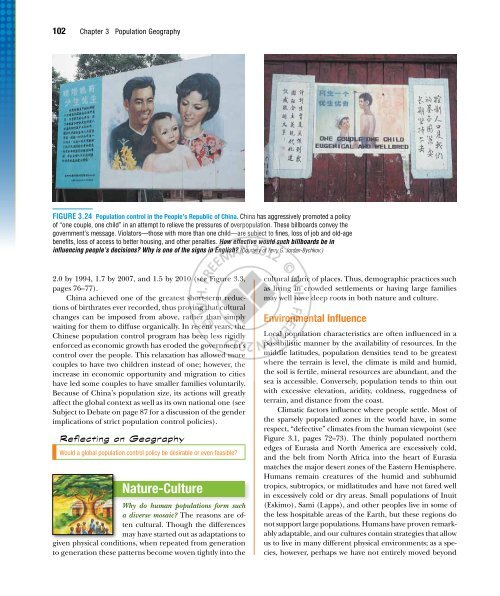Chapter 3 Population Geography - W.H. Freeman
Chapter 3 Population Geography - W.H. Freeman
Chapter 3 Population Geography - W.H. Freeman
Create successful ePaper yourself
Turn your PDF publications into a flip-book with our unique Google optimized e-Paper software.
102 <strong>Chapter</strong> 3 <strong>Population</strong> <strong>Geography</strong><br />
Figure 3.24 <strong>Population</strong> control in the People’s Republic of China. China has aggressively promoted a policy<br />
of “one couple, one child” in an attempt to relieve the pressures of overpopulation. These billboards convey the<br />
government’s message. Violators—those with more than one child—are subject to fines, loss of job and old-age<br />
benefits, loss of access to better housing, and other penalties. How effective would such billboards be in<br />
influencing people’s decisions? Why is one of the signs in English? (Courtesy of Terry G. Jordan-Bychkov.)<br />
2.0 by 1994, 1.7 by 2007, and 1.5 by 2010 (see Figure 3.3,<br />
pages 76–77).<br />
China achieved one of the greatest short-term reductions<br />
of birthrates ever recorded, thus proving that cultural<br />
changes can be imposed from above, rather than simply<br />
waiting for them to diffuse organically. In recent years, the<br />
Chinese population control program has been less rigidly<br />
enforced as economic growth has eroded the government’s<br />
control over the people. This relaxation has allowed more<br />
couples to have two children instead of one; however, the<br />
increase in economic opportunity and migration to cities<br />
have led some couples to have smaller families voluntarily.<br />
Because of China’s population size, its actions will greatly<br />
affect the global context as well as its own national one (see<br />
Subject to Debate on page 87 for a discussion of the gender<br />
implications of strict population control policies).<br />
Reflecting on <strong>Geography</strong><br />
Would a global population control policy be desirable or even feasible?<br />
Nature-Culture<br />
Why do human populations form such<br />
a diverse mosaic? The reasons are often<br />
cultural. Though the differences<br />
may have started out as adaptations to<br />
given physical conditions, when repeated from generation<br />
to generation these patterns become woven tightly into the<br />
cultural fabric of places. Thus, demographic practices such<br />
as living in crowded settlements or having large families<br />
may well have deep roots in both nature and culture.<br />
Environmental Influence<br />
Local population characteristics are often influenced in a<br />
possibilistic manner by the availability of resources. In the<br />
middle latitudes, population densities tend to be greatest<br />
where the terrain is level, the climate is mild and humid,<br />
the soil is fertile, mineral resources are abundant, and the<br />
sea is accessible. Conversely, population tends to thin out<br />
with excessive elevation, aridity, coldness, ruggedness of<br />
terrain, and distance from the coast.<br />
Climatic factors influence where people settle. Most of<br />
the sparsely populated zones in the world have, in some<br />
respect, “defective” climates from the human viewpoint (see<br />
Figure 3.1, pages 72–73). The thinly populated northern<br />
edges of Eurasia and North America are excessively cold,<br />
and the belt from North Africa into the heart of Eurasia<br />
matches the major desert zones of the Eastern Hemisphere.<br />
Humans remain creatures of the humid and subhumid<br />
tropics, subtropics, or midlatitudes and have not fared well<br />
in excessively cold or dry areas. Small populations of Inuit<br />
(Eskimo), Sami (Lapps), and other peoples live in some of<br />
the less hospitable areas of the Earth, but these regions do<br />
not support large populations. Humans have proven remarkably<br />
adaptable, and our cultures contain strategies that allow<br />
us to live in many different physical environments; as a species,<br />
however, perhaps we have not entirely moved beyond

















